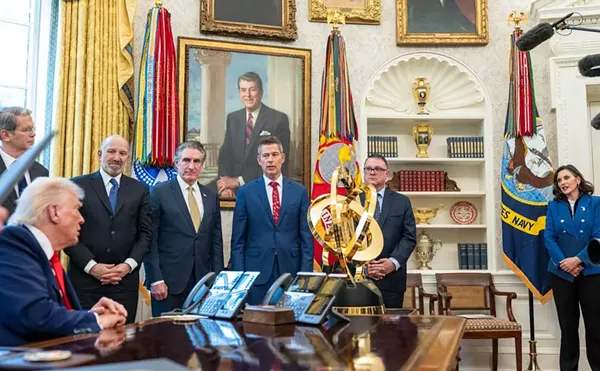
Audio By Carbonatix
[
{
"name": "GPT - Leaderboard - Inline - Content",
"component": "35519556",
"insertPoint": "5th",
"startingPoint": "3",
"requiredCountToDisplay": "3",
"maxInsertions": 100,
"adList": [
{
"adPreset": "LeaderboardInline"
}
]
}
]
They laughed at Stan Ovshinsky years ago, all the professional scientists did, when they bothered to pay attention to him at all. They had doctorates from places like Yale and Harvard. He was a high school dropout from Akron who worked in a machine shop, the son of an immigrant scrap-metal dealer.
Later, after he invented a better high-speed lathe, he began dabbling in science and then moved to Detroit. Before long, he was crazy enough to tell the scientists some of their basic assumptions about electronics were totally wrong.
Forget trying to use rigid structures to conduct electricity, he argued. A random, amorphous collection of atoms would be much more powerful semiconductors. The experts rolled their eyes. "It was like a bag lady telling Queen Elizabeth she had spit on her chin," journalist Tom Henderson said.
Nobody took him seriously at first. You've heard of alternative media? Ovshinsky was an alternative scientist, who challenged basic assumptions without the least of degrees. The scientific establishment sneered with contempt.
Stan and his wife Iris Ovshinsky pooled their savings and opened a storefront business called Energy Conversion Devices.
That was back in 1960. He told the media flat-screen technology was coming that would produce TVs you could hang on the wall. He predicted electric cars and hydrogen-powered cars and solar cell heat. Eyes rolled. Nobody took him seriously.
Finally, a highly respected physicist at the Massachusetts Institute of Technology was reluctantly pushed into testing Ovshinsky's amorphous switch.
Stunned, he proclaimed it a major breakthrough. Dr. Helmut Fritzsche, chair of the physics department at the University of Chicago, came to check out the work of this rude, uneducated upstart. He was blown away.
Before long, he was a vice president of Energy Conversion Devices, or ECD. I met him Labor Day weekend. "I've met a lot of Nobel Prize winners. Stan Ovshinsky is the only true genius I ever met," Dr. Fritzsche said at a celebration of the man's 90th birthday.
Stan Ovshinsky didn't listen to the establishment. He just did science, piling up 400 U.S. patents, and twice as many overseas. His nickel-metal-hydride battery was widely used to power laptops and cell phones. His inventions also led to the thin-film solar cells people put their roofs. Not to mention rewritable CDs, compact discs, rewritable optical discs, and various kinds of electronic memory. Most of all, he believed in alternative energy.
Half a century ago, he was worrying about climate change. He was a pioneer in electric car technology, but that's not where he saw the future. "Well, the [Chevy] Volt is nice, and will sell a few thousand cars and get people thinking," he told me two years ago. "But the real answer is hydrogen."
A few years ago, he drove me around Auburn Hills in a hydrogen-powered car. This is the future, he told me. This is a fuel that doesn't pollute, and we will never run out of, he told me. All that remained was to make it affordable.
Energy Conversion Devices went on to hire hundreds of engineers and other employees, all fiercely devoted to the dream. Sometimes, the firm made money. More often, it didn't.
Ovshinsky treated all his employees like colleagues. Few knew that, back in his youth, he had risked his life as a union organizer. Eventually, he became a millionaire from the royalties from his patents. Once, long after he was wealthy, I asked him who was his biggest hero. I expected Albert Einstein, or maybe the inventor Thomas Edison, with whom he was often compared. I wasn't even close. He answered instantly:
"Eugene V. Debs," the greatest leader of the American Socialist Party. He pulled a book off a shelf in his home, and showed me the famous quote, which I already knew by heart.
"While there is a lower class, I am in it, and while there is a criminal element I am of it, and while there is a soul in prison, I am not free." Debs wanted, a century ago, to free the wage slaves toiling without hope, wanted a better life for all.
Stan Ovshinsky never stopped trying to free mankind from dependence on fossil fuel, and to make our lives better. Impatient for more profits, the Energy Conversion Devices board five years ago ousted him from the company he founded.
They turned things over to a slick former helicopter pilot who wanted to can the science and just try to make money off one or two of Stan's inventions. The flyboy quickly ran it into the ground. ECD filed for bankruptcy and disappeared.
Ovshinsky was then 85. Anybody else would have retired and maybe written memoirs. He founded a new company, poured his own millions in, and set out to make solar cells efficient enough to compete with electricity generated by coal.
He might have gotten there, but cancer got him first. He was awarded three new patents, and almost to the last, was fighting to persuade investors to help make his new companies, Ovshinsky Innovation and Ovshinsky Solar, viable.
On Labor Day weekend, scientists from all over the world flew to Bloomfield Hills for an early 90th birthday party.
"I have to beat this. There are still things I want to do," he whispered to me. Ovshinsky lost that battle last week. He had an amazingly diverse mind. The last conversation I had with him was about the English historian Tony Judt, another man taken before his time, and what was wrong with our nation.
Throughout his life, Stan remained active in a left-wing, secular Jewish movement called Workmen's Circle. He asked that his body be buried in their cemetery in Akron.
The maverick scientist died more famous worldwide than in Detroit; those few who really comprehended his work knew that few ever understood the enormous potential of his discoveries.
His son Harvey Ovshinsky, the distinguished filmmaker, told me that as his father slipped in and out of a coma in his last days, he would sometimes rouse himself and say that he was "still trying to figure it out." His son thought about that.
"Knowing Stan, he may have." In the end, he may have done more to help the common man than those old idealistic socialists ever did. He just needed a little more time. For some men, and especially for our civilization, or whatever we call the way we live nowadays, 90 years really isn't enough.
Shame of the UAW: For many years, the one incorruptible force in labor was the United Auto Workers Union, led by the immortal Walter Reuther. But ethical giants are sometimes followed by moral pygmies.
Today's union is led instead by one Bob King, who has disgraced himself by playing footsie with Ambassador Bridge owner Matty Moroun and by refusing to oppose Proposal 6, which is designed to preserve the billionaire's monopoly and prevent construction of a bridge that would create thousands of good-paying union jobs. How could the UAW have sunk so low?
Speaking of education: If there is an educational institution in Michigan that delivers maximum value, it is Macomb Community College. It provides excellent vocational training in a broad range of fields, gets students ready for advanced universities, and puts on world-class seminars and brings in nationally famous speakers.
Macomb voters are being asked to approve a $56 million bond proposal, primarily for new technology and re-equipping college buildings. This is a huge bargain, which would cost someone who owns a $150,000 house less than $12 a year. All voters in Macomb and in their right mind should vote yes.
Jack Lessenberry opines weekly for Metro Times. Send comments to letters@metrotimes.com.





